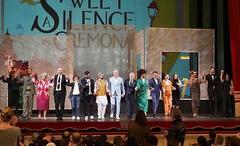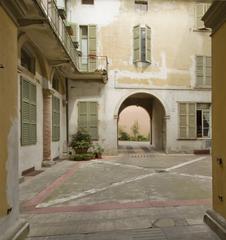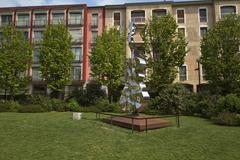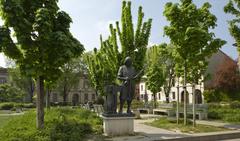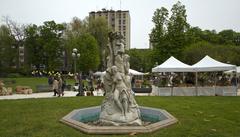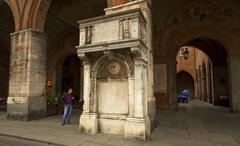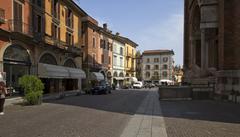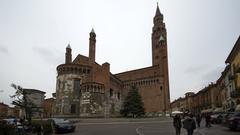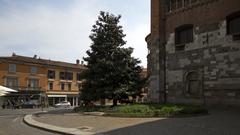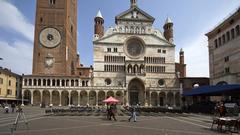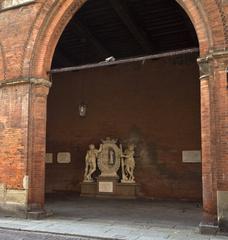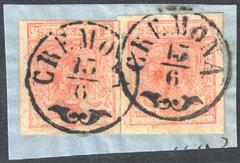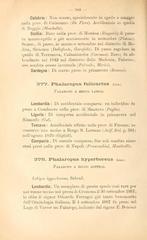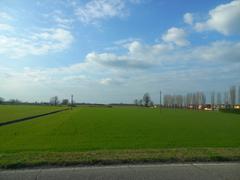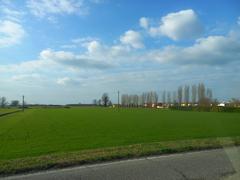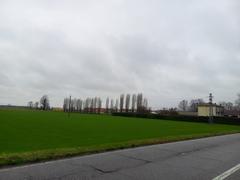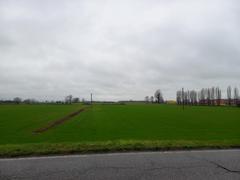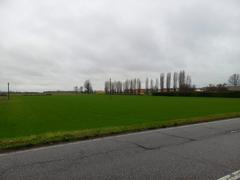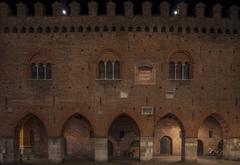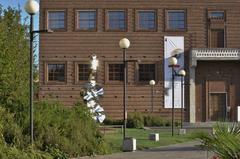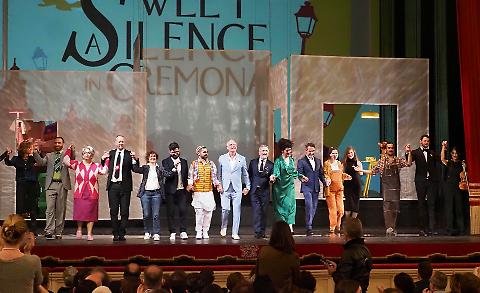
Comprehensive Guide to Visiting Piazza del Comune, Cremona, Italy
Date: 01/08/2024
Introduction
Piazza del Comune in Cremona, Italy, is a remarkable testament to the city’s rich historical and cultural heritage. Dating back to the 12th century, this central square has been the heart of civic life in Cremona and continues to be a vibrant hub of activity today. The square is renowned for its well-preserved medieval architecture, including the striking Cathedral of Cremona, the imposing Torrazzo bell tower, and the historic Palazzo Comunale. These structures not only showcase a blend of Romanesque, Gothic, Renaissance, and Baroque styles but also reflect the dual power structures of medieval times: the church and the municipality (Italy This Way). In addition to its architectural splendor, Piazza del Comune has played a significant role in Cremona’s cultural evolution, particularly in its renowned tradition of violin-making, celebrated globally through the Museo del Violino (Travel to Italy Guide). This guide aims to provide comprehensive insights into visiting Piazza del Comune, from historical background to practical travel tips, ensuring a memorable experience for every visitor.
Table of Contents
- Introduction
- Historical Background
- Modern-Day Significance
- Visitor Information
- Frequently Asked Questions (FAQ)
- Conclusion
Historical Background
Origins and Early Development
Piazza del Comune, the central square of Cremona, Italy, is a historical and cultural hub that dates back to the medieval period. The square has been the focal point of civic life in Cremona since the 12th century. It was originally designed to serve as the administrative and religious center of the city, reflecting the dual power structures of the medieval era: the church and the municipality.
The square’s layout and architecture were influenced by the need to accommodate large gatherings for both civic and religious purposes. The construction of the Cathedral of Cremona, also known as the Cathedral of Santa Maria Assunta, began in 1107 and was completed in the 14th century. This Romanesque structure, with its later Gothic, Renaissance, and Baroque additions, stands as a testament to the evolving architectural styles over the centuries (Italy This Way).
Architectural Significance
The architectural significance of Piazza del Comune is highlighted by its collection of historic buildings, each contributing to the square’s unique character. The Cathedral of Cremona, with its intricate facade and stunning frescoes, is a prime example of Romanesque architecture. The facade features a mix of white Carrara marble and red Verona marble, creating a striking visual contrast (Italian Traditions).
Adjacent to the cathedral is the Torrazzo, the tallest brick bell tower in Europe, standing at 112 meters. The tower, constructed in 754 A.D., houses one of the largest astronomical clocks in the world, which was added in the 16th century. The clock not only tells the time but also displays the days, constellations, moon phases, and eclipses (Italy This Way).
The Palazzo Comunale, built in 1206, is another significant structure in the square. Originally known as the Palazzo dei Ghibellini, it served as the headquarters for the Ghibelline Podestà. The building has undergone extensive renovations over the centuries, yet it retains its Gothic charm with its red terracotta and white marble construction (Italian Traditions).
Civic and Cultural Evolution
Piazza del Comune has been a witness to numerous historical events that have shaped the civic and cultural landscape of Cremona. During the medieval period, the square was the site of public gatherings, markets, and judicial proceedings. The Loggia dei Militi, built in 1292, served as a meeting place for the Society of Soldiers, a group of noblemen responsible for protecting the city’s significant civil objects (Italy This Way).
The Renaissance period brought about a cultural renaissance in Cremona, with the square playing a central role in the city’s artistic and musical heritage. Cremona became renowned for its violin-making tradition, with master luthiers like Antonio Stradivari and Guarneri producing some of the finest violins in history. The Museo del Violino, located near the square, houses a collection of these historic instruments and offers insights into the art of violin-making (Travel to Italy Guide).
Modern-Day Significance
Today, Piazza del Comune continues to be a vibrant center of activity in Cremona. The square hosts various cultural events, concerts, and festivals throughout the year, celebrating the city’s rich musical heritage. The daily ringing of the seven bells in the Torrazzo adds to the square’s lively atmosphere, attracting both locals and tourists alike (Italian Traditions).
The square’s historical buildings have been meticulously preserved and restored, allowing visitors to experience the architectural grandeur of medieval and Renaissance Cremona. The Cathedral of Cremona, with its stunning frescoes by artists like Giovanni Antonio da Pordenone and Boccaccio Boccaccino, remains a major attraction for art enthusiasts (Italy This Way).
Visitor Information
Visiting Hours and Tickets
The Cathedral of Cremona is typically open from 7:30 AM to 12:30 PM and from 3:00 PM to 7:00 PM. The Torrazzo is open from 10:00 AM to 5:30 PM, with the last admission at 5:00 PM. Ticket prices for the Torrazzo are around €5 for adults, with discounts available for children and seniors. It’s advisable to check the official website for the most up-to-date information on visiting hours and ticket prices.
Travel Tips
For those planning to visit Piazza del Comune, it is recommended to start the tour at the Cathedral of Cremona. Take time to admire the intricate details of the facade and the beautiful frescoes inside. Climbing the Torrazzo is a must for panoramic views of the city and the surrounding countryside. The climb involves 502 steps, but the breathtaking views from the top are well worth the effort (Savoring Italy).
Next, explore the Palazzo Comunale and the Loggia dei Militi to get a sense of the square’s civic history. The Museo del Violino is another highlight, offering a deep dive into Cremona’s violin-making tradition. Visitors can watch live demonstrations of master craftsmen at work and learn about the history of violin-making in Cremona (Travel to Italy Guide).
Finally, take a leisurely stroll around the square, soaking in the lively atmosphere and perhaps stopping for a coffee at one of the charming cafes. The square is also a great place to sample some of Cremona’s culinary delights, such as torrone (nougat) and mostarda (spiced fruit preserves) (Savoring Italy).
Nearby Attractions
While in Cremona, consider visiting other nearby attractions such as the Museo Archeologico, which houses ancient artifacts, or the Palazzo Trecchi, a stunning example of Renaissance architecture. The nearby Church of San Sigismondo is also worth a visit for its beautiful frescoes and serene atmosphere.
Frequently Asked Questions (FAQ)
What are the opening hours of Piazza del Comune? The square itself is open 24/7, but individual attractions like the Cathedral and Torrazzo have specific visiting hours. The Cathedral is open from 7:30 AM to 12:30 PM and from 3:00 PM to 7:00 PM, while the Torrazzo is open from 10:00 AM to 5:30 PM.
How much are tickets for the Torrazzo? Tickets for the Torrazzo are around €5 for adults, with discounts available for children and seniors.
Are there guided tours available? Yes, guided tours are available and can be booked through the official Cremona tourism website or at the tourist information center in the square.
Is Piazza del Comune accessible for people with disabilities? The square is mostly accessible, but some historical buildings, such as the Torrazzo, may have limited accessibility due to their age and structure.
What events take place at Piazza del Comune? The square hosts various events throughout the year, including cultural festivals, music concerts, and public gatherings. Check the official Cremona events calendar for the latest updates.
Conclusion
In conclusion, Piazza del Comune in Cremona is not merely a historical landmark but a living embodiment of the city’s rich cultural and architectural heritage. From the majestic Cathedral of Cremona and the towering Torrazzo to the civic heart at the Palazzo Comunale, the square offers a unique glimpse into the medieval and Renaissance eras. Today, it continues to be a vibrant center for cultural events, festivals, and daily life, attracting visitors from around the world. Whether you’re a history aficionado, an art enthusiast, or a music lover, Piazza del Comune provides a myriad of experiences that cater to diverse interests. By planning your visit, exploring its historical sites, and engaging with local culture, you will undoubtedly gain a deeper appreciation for this iconic square. For detailed visitor information and up-to-date event schedules, refer to official sources like Turismo Cremona and in-Lombardia. Don’t miss the chance to immerse yourself in the rich tapestry of history and culture that Piazza del Comune has to offer.
References
- Italy This Way, n.d., Italy This Way source url
- Italian Traditions, n.d., Italian Traditions source url
- Travel to Italy Guide, n.d., Travel to Italy Guide source url
- Lonely Planet, n.d., Lonely Planet source url
- Turismo Cremona, n.d., Turismo Cremona source url
- Cremona Music Festival, n.d., Cremona Music Festival source url
- Savoring Italy, n.d., Savoring Italy source url
